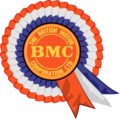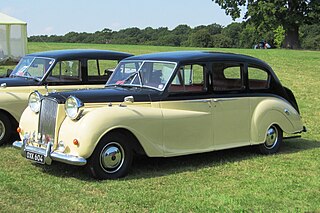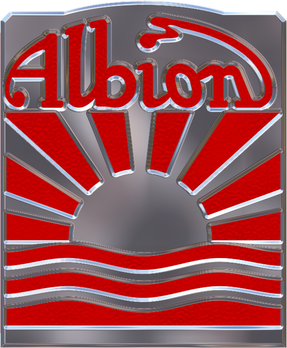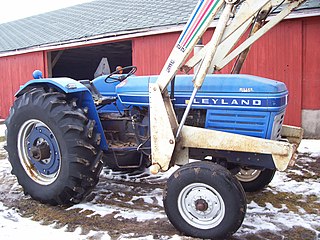
The British Motor Corporation Limited (BMC) was a UK-based vehicle manufacturer, formed in early 1952 to give effect to an agreed merger of the Morris and Austin businesses.

The Austin Motor Company Limited was an English manufacturer of motor vehicles, founded in 1905 by Herbert Austin in Longbridge. In 1952 it was merged with Morris Motors Limited in the new holding company British Motor Corporation (BMC) Limited, keeping its separate identity. The marque Austin was used until 1987. The trademark is currently owned by the Chinese firm SAIC Motor, after being transferred from bankrupt subsidiary Nanjing Automotive which had acquired it with MG Rover Group in July 2005.

British Leyland was an automotive engineering and manufacturing conglomerate formed in the United Kingdom in 1968 as British Leyland Motor Corporation Ltd (BLMC), following the merger of Leyland Motors and British Motor Holdings. It was partly nationalised in 1975, when the UK government created a holding company called British Leyland, later renamed BL in 1978. It incorporated much of the British-owned motor vehicle industry, which in 1968 had a 40 per cent share of the UK car market, with its history going back to 1895. Despite containing profitable marques such as Jaguar, Rover, and Land Rover, as well as the best-selling Mini, BLMC had a troubled history, leading to its eventual collapse in 1975 and subsequent part-nationalisation.

The Austin Princess is a series of large luxury cars that were made by Austin and its subsidiary Vanden Plas from 1947 to 1968. The cars were also marketed under the Princess and Vanden Plas marque names.

Riley was a British motorcar and bicycle manufacturer from 1890. Riley became part of the Nuffield Organization in 1938 and was merged into the British Leyland Motor Corporation in 1968. In July 1969 British Leyland announced the immediate end of Riley production, although 1969 was a difficult year for the UK automotive industry and many cars from Riley's inventory may have been first registered in 1970.

Hindustan Motors is an Indian automotive manufacturer based in Kolkata, West Bengal, India. It is a part of the Birla Technical Services conglomerate. The company was the largest car manufacturer in India before the rise of Maruti Udyog.

The Austin Motor Company A-series is a British small straight-4 automobile engine. Launched in 1951 with the Austin A30, production lasted until 2000 in the Mini. It used a cast-iron block and cylinder head, and a steel crankshaft with three main bearings. The camshaft ran in the cylinder block, driven by a single-row chain for most applications, and with tappets sliding in the block, accessible through pressed steel side covers for most applications, and with overhead valves operated through rockers. The cylinder blocks are not interchangeable between versions intended for conventional end-on mounted gearboxes and the 'in-sump' transaxle used on British Motor Corporation/British Leyland front wheel drive models such as the Mini. The cylinder head for the overhead-valve version of the A-series engine was designed by Harry Weslake – a cylinder head specialist famed for his involvement in SS (Jaguar) engines and several Formula One-title winning engines. Although a "clean sheet" design, the A-series owed much to established Austin engine design practise, resembling in general design and overall appearance a scaled-down version of the 1200cc overhead-valve engine first seen in the Austin A40 Devon which would form the basis of the later B-series engine.

The BMC B series was a line of straight-4 & straight-6 internal combustion engine mostly used in motor cars, created by British automotive manufacturer Austin Motor Company.

Nuffield Organization was the unincorporated umbrella-name or promotional name used for the charitable and commercial interests of owner and donor, William Morris, 1st Viscount Nuffield. The name was assumed following Nuffield's gift made to form his Nuffield Foundation in 1943, it linked his business interests to his existing very generous philanthropy. The same enterprises had previously been referred to as the Morris Organizations and at first described itself as The Nuffield Organization, A Cornerstone of Britain's Industrial Structure.

Wolseley Motors Limited was a British motor vehicle manufacturer founded in early 1901 by the Vickers Armaments in conjunction with Herbert Austin. It initially made a full range, topped by large luxury cars, and dominated the market in the Edwardian era. The Vickers brothers died and, without their guidance, Wolseley expanded rapidly after the war, manufacturing 12,000 cars in 1921, and remained the biggest motor manufacturer in Britain.

Albion Motors was a Scottish automobile and commercial vehicle manufacturer.

BMC Otomotiv Sanayi ve Ticaret A.Ş., doing business as BMC Otomotiv and BMC, is one of the largest automobile manufacturers in Turkey. Its products include commercial trucks, buses, military trucks and armoured vehicles. The company was founded in 1964 by Ergün Özakat in partnership of British Motor Corporation which held a 26% stake. It was purchased by Çukurova Holding in 1989, and seized by the Turkish government's TMSF in 2013. BMC has been taken over with a final bid of TL 751M, by a partnership of 51% Turkish side and 49% Qatari side.
British Motor Corporation (Australia) was a motor manufacturing company formed in Australia in 1954 by the merger of the Austin Motor Company (Australia) and Nuffield (Australia). This followed the merger in 1952 of the Austin Motor Company and the Nuffield Group in the United Kingdom to form the British Motor Corporation. Following further corporate changes in the UK in the late 1960s, BMC Australia was absorbed into the newly established British Leyland Motor Corporation of Australia, the name of which became Leyland Motor Corporation of Australia in 1972, and then JRA Limited in March 1983.
Continental Motors Company was an American manufacturer of internal combustion engines. The company produced engines as a supplier to many independent manufacturers of automobiles, tractors, trucks, and stationary equipment from the 1900s through the 1960s. Continental Motors also produced automobiles in 1932–1933 under the name Continental Automobile Company. The Continental Aircraft Engine Company was formed in 1929 to develop and produce its aircraft engines, and would become the core business of Continental Motors, Inc.

Leyland tractors was a tractor manufacturer in the United Kingdom. It was created after the merger of the British Motor Corporation (BMC) with Leyland Motors to form British Leyland in 1968. Nuffield Tractors had been started after World War II by Lord Nuffield owner of Morris Motors Limited which had become part of BMC in 1951.

The Standard Atlas is a light van which was produced and sold under various names between 1958 and 1980, initially in Britain and Europe, and subsequently in India.

Morris Oxford is a series of motor car models produced by Morris Motors of the United Kingdom, from the 1913 bullnose Oxford to the Farina Oxfords V and VI.

The Oliver 60 series of row-crop tractors was a product line of agricultural tractors produced from 1940 to 1964 by the Oliver Farm Equipment Company. The 60 series was a four-cylinder follow-on to the six-cylinder Oliver 70. As the 70 was outsold by the less-expensive Farmall A, Allis-Chalmers Model B and John Deere Model B, Oliver introduced the 60 to compete.

The Morris WE/Austin S203/S403/S503 was a bonneted truck produced by the British Motor Corporation from 1955. After a revision in 1964, it was marketed as the Morris WF/Austin S303/S403/S503 and from 1968 as the BMC WF. In the export markets, the Austin model was usually called the Morris, WE/WF. After BMC merged with Leyland Motors to form the British Leyland Motor Corporation, it was produced as the Leyland WF from 1970 to 1981 and replaced by the Leyland Landmaster.






















